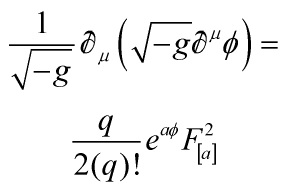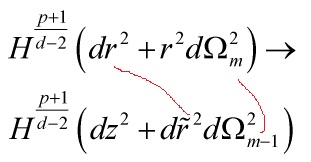I will discuss one of the deepest aspects of string/M-theory, namely the AdS/CFT duality, expressed as
and spacelike branes, whose action is generally of the form
![]()
which is ![]() time the Dirac-Born-Infeld action
time the Dirac-Born-Infeld action
over the target space ![]() and
and
![]()
is a Dirac delta function interpreted as a distribution along ![]() directions, and briefly discuss cosmological singularities. This is an excellent read on S-branes. It is folklore knowledge that any Minkowskian geometry of the worldvolume of a p-brane can be replaced with any Ricci-flat spacetime with Kasner-time-dependence and satisfying the Dp-brane worldvolumes can be replaced by a Friedmann-Robertson-Walker metric with a conformal factor. It can be shown that there is a deep mathematical relation between p-branes and chargeless S-brane worldvolume backgrounds related the via AdS/CFT duality with a Maldacena deformation satisfying U-duality.
directions, and briefly discuss cosmological singularities. This is an excellent read on S-branes. It is folklore knowledge that any Minkowskian geometry of the worldvolume of a p-brane can be replaced with any Ricci-flat spacetime with Kasner-time-dependence and satisfying the Dp-brane worldvolumes can be replaced by a Friedmann-Robertson-Walker metric with a conformal factor. It can be shown that there is a deep mathematical relation between p-branes and chargeless S-brane worldvolume backgrounds related the via AdS/CFT duality with a Maldacena deformation satisfying U-duality.
The d-dimensional Einstein frame action describing bosonic sectors of supergravity theories containing the graviton, ![]() , the dilaton
, the dilaton ![]() coupled to the q-form field strength
coupled to the q-form field strength
![]()
with the coupling constant ![]() is given as
is given as
with the field equations:
![]()
and
and the field strength satisfying the Bianchi identity
![]()
It is solutions that describe a p-brane in the presence of a chargeless S-brane without any smearing in p-brane’s transverse space that is central, and here is where time comes in, as I will show that
![Rendered by QuickLaTeX.com \[\left\{ {\begin{array}{*{20}{c}}{\phi = \varepsilon a{\rm{In}}H + \gamma t}\\{{F_{t1...pr}} = {Q^ * }\left[ {Vol\left( {{\Omega _m}} \right)} \right]\left( E \right)}\\{{F_{1...m}} = Q\,vol\left( {{\Omega _m}} \right)\left( M \right)}\end{array}} \right.\]](https://www.georgeshiber.com/wp-content/ql-cache/quicklatex.com-d0348fe952fcc769e641cd6462ef131e_l3.png)
with ![]() being the volume form of the m-dimensional unit sphere
being the volume form of the m-dimensional unit sphere ![]() and ‘
and ‘![]() ‘ the Hodge dual operation with respect to full metric. Note now that in the metric above,
‘ the Hodge dual operation with respect to full metric. Note now that in the metric above,
![]()
represents the metric on the n-dimensional unit hyperbola, unit sphere or flat space and the function ![]() is given as
is given as
and our constants do satisfy
![Rendered by QuickLaTeX.com \[\beta = - \frac{1}{{n - 1}}\left( {\sum\limits_{i = 0}^{k - 1} {{b_i} - \frac{{\left( {m + 1} \right)\gamma \varepsilon a}}{{d - p - 3}}} } \right)\]](https://www.georgeshiber.com/wp-content/ql-cache/quicklatex.com-3a9ed0a44f95e8281f7f4bc420ab3f39_l3.png)
![Rendered by QuickLaTeX.com \[\begin{array}{c}n\left( {n - 1} \right){M^2} = \left( {n - 1} \right){\beta ^2} + \\\sum\limits_{i = 0}^{k - 1} {b_i^2} + + \frac{{\left( {m + 1} \right){\gamma ^2}{a^2}}}{{{{\left( {d - p - 3} \right)}^2}}} + \frac{{{\gamma ^2}}}{2}\end{array}\]](https://www.georgeshiber.com/wp-content/ql-cache/quicklatex.com-6465f2667f5cde3488d97d1d34539730_l3.png)
Deep: if one sets all time-dependent parts to zero, the solution is exactly the p-brane solution
and the dilaton coupling ‘![]() ‘ is zero in 11-D SUGRA and in type IIA and IIB SUGRAs, it is given by
‘ is zero in 11-D SUGRA and in type IIA and IIB SUGRAs, it is given by
![]()
Thus, the solution below
![Rendered by QuickLaTeX.com \[\left\{ {\begin{array}{*{20}{c}}{\phi = \varepsilon a{\rm{In}}H + \gamma t}\\{{F_{t1...pr}} = {Q^ * }\left[ {Vol\left( {{\Omega _m}} \right)} \right]\left( E \right)}\\{{F_{1...m}} = Q\,vol\left( {{\Omega _m}} \right)\left( M \right)}\end{array}} \right.\]](https://www.georgeshiber.com/wp-content/ql-cache/quicklatex.com-d0348fe952fcc769e641cd6462ef131e_l3.png)
can be interpreted as a superposition of a p-brane with a chargeless S-brane
Now note that one of the constants ![]() can be set to 1 by rescaling the time coordinate. There are generic singularities as
can be set to 1 by rescaling the time coordinate. There are generic singularities as ![]() , as can be seen from the collapse of parts of the metric functions. When
, as can be seen from the collapse of parts of the metric functions. When ![]() is finite, time-dependent metric functions are well-behaved except for the
is finite, time-dependent metric functions are well-behaved except for the ![]() function G above, which ought and does become zero at
function G above, which ought and does become zero at ![]() .
.
However, and that is the deep point, this is not a singularity
since one can always define a new coordinate
![]()
thus getting
![]()
which is exactly the flat spacetime in Rindler-coordinates. So, for ![]() , one gets
, one gets
![Rendered by QuickLaTeX.com \[\left\{ {\begin{array}{*{20}{c}}{t \in \left( {{t_0},\infty } \right)}\\{{\rm{or}}}\\{t \in \left( { - \infty ,{t_0}} \right)}\end{array}} \right.\]](https://www.georgeshiber.com/wp-content/ql-cache/quicklatex.com-06dfa104b1b5dc8753ef401f8e507f6a_l3.png)
and for ![]() , we get
, we get
![]()
and for the general solution
![Rendered by QuickLaTeX.com \[\left\{ {\begin{array}{*{20}{c}}{\phi = \varepsilon a{\rm{In}}H + \gamma t}\\{{F_{t1...pr}} = {Q^ * }\left[ {Vol\left( {{\Omega _m}} \right)} \right]\left( E \right)}\\{{F_{1...m}} = Q\,vol\left( {{\Omega _m}} \right)\left( M \right)}\end{array}} \right.\]](https://www.georgeshiber.com/wp-content/ql-cache/quicklatex.com-d0348fe952fcc769e641cd6462ef131e_l3.png)
we can smear some directions from the ![]() -replacement
-replacement
with the harmonic function ![]() now independent of
now independent of ![]() -coordinate.
-coordinate.
Hence, we have Dp-and-Mq-brane solution in S-Dp-brane backgrounds with no singularity, ‘living’ in the bulk of
![]()
satisfying singularity-free Friedmann-Robertson-Walker type time-dependent dynamics on the boundary
and this is deep, and to be continued, however, I must discuss the problem(s) of time in physics.









